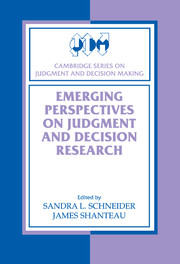Book contents
- Frontmatter
- Contents
- List of Contributors
- Preface
- Acknowledgments
- Introduction: Where to Decision Making?
- Part I Fortifying Traditional Models of Decision Making
- Part II Elaborating Cognitive Processes in Decision Making
- Part III Incorporating Affect and Motivation in Decision Making
- Part IV Understanding Social and Cultural Influences on Decisions
- Part V Facing the Challenge of Real-World Complexity in Decisions
- Part VI Commentary
- Author Index
- Subject Index
Introduction: Where to Decision Making?
Published online by Cambridge University Press: 05 June 2012
- Frontmatter
- Contents
- List of Contributors
- Preface
- Acknowledgments
- Introduction: Where to Decision Making?
- Part I Fortifying Traditional Models of Decision Making
- Part II Elaborating Cognitive Processes in Decision Making
- Part III Incorporating Affect and Motivation in Decision Making
- Part IV Understanding Social and Cultural Influences on Decisions
- Part V Facing the Challenge of Real-World Complexity in Decisions
- Part VI Commentary
- Author Index
- Subject Index
Summary
The Plan
The overriding goal of this book is to provide a forum for fresh perspectives on decision making. The aim is to expose readers to a wide variety of promising perspectives for enhancing the scope of judgment and decision-making research. The specific purposes of the book are (a) to bridge the gap between traditional decision-making paradigms and newer lines of research and theory; (b) to expand awareness of these new theories and approaches; and (c) to demonstrate how these alternative approaches can enhance development of the judgment and decision-making field. The chapters in this volume illustrate how much richer the field is becoming through attention to a number of novel perspectives that have not been a part of traditional judgment and decision making approaches.
Over the past several years, there has been a growing concern that the progress of decision-making research may be limited by focusing heavily on traditional schools of thought (e.g., approaches emphasizing deviations from rationality and utility theory). At the same time, there has been accumulating evidence to show that numerous unexplored factors are likely to impact judgment and choice. For example, many researchers have come to appreciate the vital roles that memory, context, and emotion play in determining decision strategies. This volume provides a forum for updating assumptions of traditional schools of thought as well as introducing new perspectives that push the envelope of judgment and decision-making paradigms.
- Type
- Chapter
- Information
- Publisher: Cambridge University PressPrint publication year: 2003



